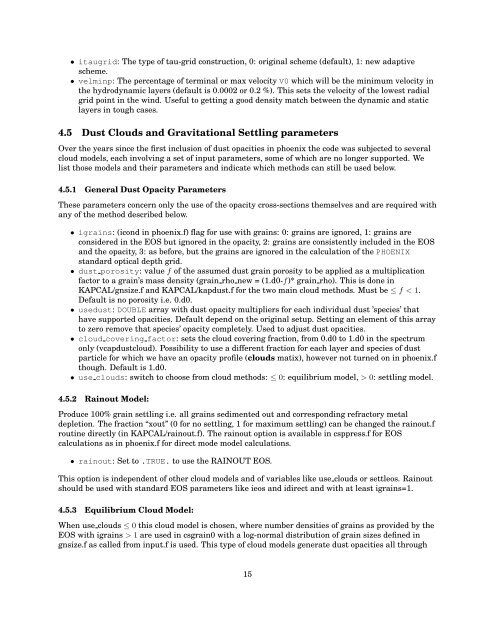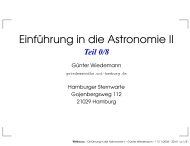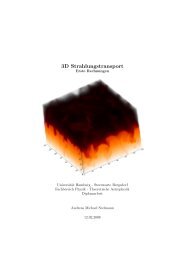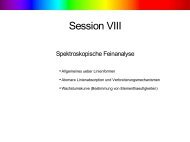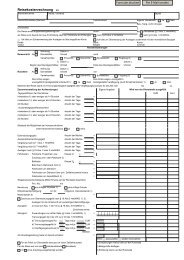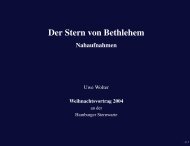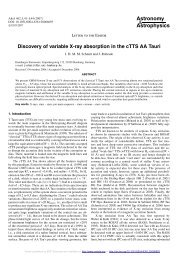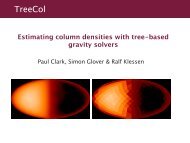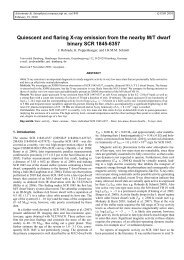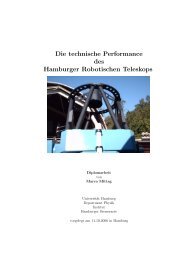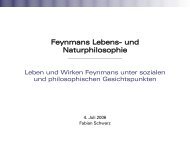Version 15 June 2007 compiled: 11-11-2009 - Hamburger Sternwarte
Version 15 June 2007 compiled: 11-11-2009 - Hamburger Sternwarte
Version 15 June 2007 compiled: 11-11-2009 - Hamburger Sternwarte
Create successful ePaper yourself
Turn your PDF publications into a flip-book with our unique Google optimized e-Paper software.
• itaugrid: The type of tau-grid construction, 0: original scheme (default), 1: new adaptive<br />
scheme.<br />
• velminp: The percentage of terminal or max velocity V0 which will be the minimum velocity in<br />
the hydrodynamic layers (default is 0.0002 or 0.2 %). This sets the velocity of the lowest radial<br />
grid point in the wind. Useful to getting a good density match between the dynamic and static<br />
layers in tough cases.<br />
4.5 Dust Clouds and Gravitational Settling parameters<br />
Over the years since the first inclusion of dust opacities in phoenix the code was subjected to several<br />
cloud models, each involving a set of input parameters, some of which are no longer supported. We<br />
list those models and their parameters and indicate which methods can still be used below.<br />
4.5.1 General Dust Opacity Parameters<br />
These parameters concern only the use of the opacity cross-sections themselves and are required with<br />
any of the method described below.<br />
• igrains: (icond in phoenix.f) flag for use with grains: 0: grains are ignored, 1: grains are<br />
considered in the EOS but ignored in the opacity, 2: grains are consistently included in the EOS<br />
and the opacity, 3: as before, but the grains are ignored in the calculation of the PHOENIX<br />
standard optical depth grid.<br />
• dust porosity: value f of the assumed dust grain porosity to be applied as a multiplication<br />
factor to a grain’s mass density (grain rho new = (1.d0-f)* grain rho). This is done in<br />
KAPCAL/gnsize.f and KAPCAL/kapdust.f for the two main cloud methods. Must be ≤ f < 1.<br />
Default is no porosity i.e. 0.d0.<br />
• usedust: DOUBLE array with dust opacity multipliers for each individual dust ’species’ that<br />
have supported opacities. Default depend on the original setup. Setting an element of this array<br />
to zero remove that species’ opacity completely. Used to adjust dust opacities.<br />
• cloud covering factor: sets the cloud covering fraction, from 0.d0 to 1.d0 in the spectrum<br />
only (vcapdustcloud). Possibility to use a different fraction for each layer and species of dust<br />
particle for which we have an opacity profile (clouds matix), however not turned on in phoenix.f<br />
though. Default is 1.d0.<br />
• use clouds: switch to choose from cloud methods: ≤ 0: equilibrium model, > 0: settling model.<br />
4.5.2 Rainout Model:<br />
Produce 100% grain settling i.e. all grains sedimented out and corresponding refractory metal<br />
depletion. The fraction “xout” (0 for no settling, 1 for maximum settling) can be changed the rainout.f<br />
routine directly (in KAPCAL/rainout.f). The rainout option is available in csppress.f for EOS<br />
calculations as in phoenix.f for direct mode model calculations.<br />
• rainout: Set to .TRUE. to use the RAINOUT EOS.<br />
This option is independent of other cloud models and of variables like use clouds or settleos. Rainout<br />
should be used with standard EOS parameters like ieos and idirect and with at least igrains=1.<br />
4.5.3 Equilibrium Cloud Model:<br />
When use clouds ≤ 0 this cloud model is chosen, where number densities of grains as provided by the<br />
EOS with igrains > 1 are used in csgrain0 with a log-normal distribution of grain sizes defined in<br />
gnsize.f as called from input.f is used. This type of cloud models generate dust opacities all through<br />
<strong>15</strong>


